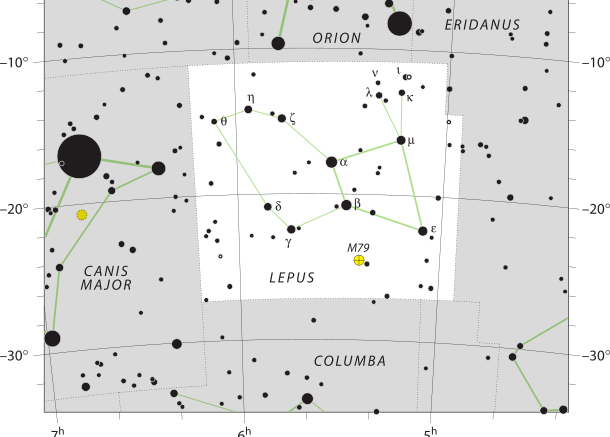The constellation Lepus that is located to the south of the celestial equator. The name of the constellation is Latin for hare. It is located immediately south of the constellation Orion, which means that the constellation is sometimes represented as a hare being chased by Orion or by Orion’s hunting dogs.
The constellation is visible to all observers at latitudes between +63° and -90°. Lepus has no Greek mythology related story on its own but is connected to the myths of Orion and his hunting dogs.
| Applicable Information | |
| Visibility In Pacific Northwest | October to March |
| Best Times To View | January |
| Right Ascension | 6h |
| Declination | −20° |
| Area | 290 square degrees |
| Main Stars | 8 |
| Brightest Object | α Lep, Arneb |
| Meteor showers | 0 |
| Messier objects | 1 |
| Neighboring Constellations | Orion, Monoceros, Canis Major, Columba, Caelum, Eridanus |
History/Facts
Lepus was first catalogued by the Greek astronomer Ptolemy in the 2nd century.
Lepus is the 51st constellation in size, occupying an area of 290 square degrees.
Stars
Lepus contains a number of bright stars, with the brightest being Arneb. Arneb has a visual magnitude of 2.58 with its name means “the hare” in Arabic. The second brightest star is Nihal with a magnitude of 2.84. Nihal is a yellow giant star that lies 160 light years from our solar system. Sasin is the third brightest star with a magnitude of 3.16. It is an orange giant star located about 213 light years away.
There is 1 Messier object in Lepus, which is M79, which is a globular cluster of magnitude 8.0. M79 is 1 of the few globular clusters visible in the winter for observers in the Northern Celestial Hemisphere. It is a Shapley class V cluster, which means that it has an intermediate concentration towards its center.
Make sure to check out other articles on the site, including a brief introduction to constellations, other constellation articles, and more!

Be the first to comment on "Lepus"